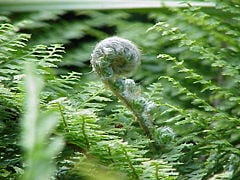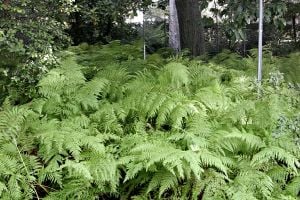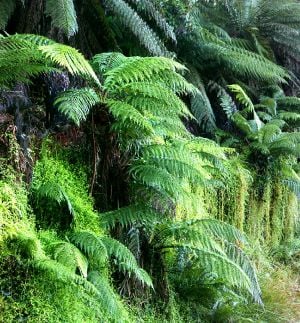Fern
| Ferns (Pteridophyta) | ||||
|---|---|---|---|---|
 Polystichum setiferum showing unrolling young frond | ||||
| Scientific classification | ||||
| ||||
| Classes | ||||
|
Marattiopsida |
A fern, or pteridophyte, is any one of a group of plants classified in the Division Pteridophyta, formerly known as Filicophyta. A fern is a vascular plant that differs from the more primitive lycophytes in having true leaves (megaphylls) and from the more advanced seed plants (gymnosperms and angiosperms) in lacking seeds, and instead reproducing with spores.
There are an estimated 10-15,000 known species of ferns, classified in about 40 families (Swale 2000). There are also plants known as "fern allies" that are also vascular plants and reproduce via spores, but are not true ferns. Hassler and Swale (2001) compiled a list of 12,838 ferns and fern allies in three classes, 19 orders, 58 families, and 316 genera.
Ferns are among the oldest land plants, dating back to the Carboniferous period (359 to 299 million years ago), when they considered to have been the dominant type of vegetation. The fronds of some Carboniferous ferns are almost identical with those of living species. Reproduction via spores preceded the development of angiosperm reproduction.
Ferns range in size from some aquatic species a few centimeters high to some tree ferns that can grow more than 20 meters high with fronds over three meters.
Fern distribution
Ferns are distributed throughout the world, including tropical, temperate, and Arctic environments, although most species are located in tropical regions. They tend to grow in shady, damp areas, but are also found on rocks and dry ground. Some species grow on trees.
Families such as Marattiaceae, Gleicheniaceae, Grammitidaceae, Schizaeaceae, Cyatheaceae, Blechnaceae, and Davalliaceae are almost exclusive to the tropics, and the genera Athyrium, Cystopteris, Dryopteris, Polystichum are exclusive to temperate and Arctic regions.
Many species of fern are disjunct populations across a geographic range, which is thought to be the result of long distance dispersal of spores; however, disjunct populations across continents have also been found. These are thought to be ancient remnant populations dating back to a time when the continents were arranged differently and the populations linked together.
Fern structure
Like the sporophytes of seed plants, those of ferns consist of:
- Stems: Most often an underground creeping rhizome, but sometimes an above-ground creeping stolon, aerial shoot from a plant with the ability to produce adventitious roots and new offshoots of the same plant (e.g., Polypodiaceae), or an above-ground erect semi-woody trunk (e.g., Cyatheaceae) reaching up to 20 m in a few species (e.g., Cyathea brownii on Norfolk Island and Cyathea medullaris in New Zealand).
- Leaf: The green, photosynthetic part of the plant. In ferns, it is often referred to as a frond, but this is because of the historical division between people who study ferns and people who study seed plants, rather than because of differences in structure. New leaves typically expand by the unrolling of a tight spiral called a crozier or fiddlehead. This uncurling of the leaf is termed circinate vernation. Leaves are divided into two types:
- Trophophyll: A leaf that does not produce spores, instead only producing sugars by photosynthesis. Analogous to the typical green leaves of seed plants.
- Sporophyll: A leaf that produces spores. These leaves are analogous to the scales of pine cones or to stamens and pistil in gymnosperms and angiosperms, respectively. Unlike the seed plants, however, the sporophylls of ferns are typically not very specialized, looking similar to trophophylls and producing sugars by photosynthesis as the trophophylls do.
- Roots: The underground non-photosynthetic structures that take up water and nutrients from soil. They are always fibrous and are structurally very similar to the roots of seed plants.
The gametophytes of ferns, however, are very different from those of seed plants. They typically consist of:
- Prothallus: A green, photosynthetic structure that is one cell thick, usually heart- or kidney-shaped, 3-10 mm long and 2-8 mm broad. The thallus produces gametes by means of:
- Antheridia: Small spherical structures that produce flagellate sperm.
- Archegonia: A flask-shaped structure that produces a single egg at the bottom, reached by the sperm by swimming down the neck.
- Sporangiia: The reproductive structure of ferns. These are small sacks or capsules containing the spores by which ferns reproduce. This structure is found on the underside of the frond, arranged in a pattern associated with the veination of the leaf. Sometimes ferns provide a protective covering for the sorus called the indusium.
- Rhizoids: root-like structures that consist of single greatly-elongated cells that take up water and nutrients.
Life Cycle
Like all vascular plants, ferns have a life cycle often referred to as alternation of generations, characterized by a diploid sporophytic and a haploid gametophytic phase. Unlike the gymnosperms and angiosperms, in ferns the gametophyte is a free-living organism. The life cycle of a typical fern is as follows:
- A sporophyte (diploid) phase produces haploid spores by meiosis;
- A spore grows by cell division into a gametophyte, which typically consists of a photosynthetic prothallus, a short-lived and inconspicuous heart-shaped structure typically two to five millimeters wide, with a number of rhizoids (root-like hairs) growing underneath, and the sex organs.
- The gametophyte produces gametes (often both sperm and eggs on the same prothallus) by mitosis
- A mobile, flagellate sperm fertilizes an egg that remains attached to the prothallus
- The fertilized egg is now a diploid zygote and grows by mitosis into a sporophyte (the typical "fern" plant).
Evolution and classification
Ferns first appear in the fossil record in the early-Carboniferous epoch. By the Triassic, the first evidence of ferns related to several modern families appeared. The "great fern radiation" occurred in the late-Cretaceous, when many modern families of ferns first appeared.
Ferns have traditionally been grouped in the Class Filices, but modern classifications assign them their own division in the plant kingdom, called Pteridophyta.
Two related groups of plants, commonly known as ferns, are actually more distantly related to the main group of "true" ferns. These are the whisk ferns (Psilotophyta) and the adders-tongues, moonworts, and grape-ferns (Ophioglossophyta). The Ophioglossophytes were formerly considered true ferns and grouped in the Family Ophioglossaceae, but were subsequently found to be more distantly related. Some classification systems include the Psilopytes and Ophioglossophytes in Division Pteridophyta, while others assign them to separate divisions. Modern phylogeny indicates that the Ophioglossophytes, Psilotopytes, and true ferns together constitute a monophyletic group, descended from a common ancestor.
Recent phylogenetic studies suggest that horsetails, Equisetaceae, are derived "ferns." More recently (Pryer, et al. 2004) clubmosses, spikemosses, and quillworts have been grouped as lycophytes. All ferns, whisk ferns, and horsetails have been grouped as monilophytes.
The true ferns may be subdivided into four main groups, or classes (or orders if the true ferns are considered as a class):
- Marattiopsida
- Osmundopsida
- Gleicheniopsida
- Pteridopsida
The last group includes most plants familiarly known as ferns. The Marattiopsida are a primitive group of tropical ferns with a large, fleshy rhizome, and are now thought to be a sibling taxon to the main group of ferns, the leptosporangiate ferns, which include the other three groups listed above. Modern research suggests that the Osmundopsida diverged first from the common ancestor of the leptosporangiate ferns, followed by the Gleichenopsida.
A more complete classification scheme follows:
- Division: Pteridophyta
- Class: Marattiopsida
- Order: Marattiales
- Order: Christenseniales
- Class: Osmundopsida
- Order: Osmundales (the flowering ferns)
- Class: Gleicheniopsida
- Subclass: Gleicheniatae
- Order: Gleicheniales (the forked ferns)
- Order: Dipteridales
- Order: Matoniales
- Subclass: Hymenophyllatae
- Order: Hymenophyllales (the filmy ferns)
- Subclass: Hymenophyllopsitae
- Order: Hymenophyllopsidales
- Subclass: Gleicheniatae
- Class: Pteridopsida
- Subclass: Schizaeatae
- Order: Schizeales (including the climbing ferns)
- heterosporous ferns
- Order: Marsileales (Hydropteridales) (the water-clovers, mosquito fern, water-spangle)
- Subclass: Cyatheatae
- Order: Cyatheales (the tree ferns)
- Order: Plagiogyriales
- Order: Loxomales
- Subclass: Pteriditae
- Order: Lindseales
- Order: Pteridales (including the brakes and maidenhair ferns)
- Order: Dennstaedtiales (the cup ferns, including bracken)
- Subclass: Polypoditae
- Order: Aspleniales (the spleenworts)
- Order: Athyriales (including the lady ferns, ostrich fern, maiden ferns, etc.)
- Order: Dryopteridales (the wood ferns and sword ferns)
- Order: Davalliales (including the rabbits-foot ferns and Boston ferns)
- Order: Polypodiales (including the rock-cap ferns or Polypodies)
- Subclass: Schizaeatae
- Class: Marattiopsida
Fern allies
Fern ally is a general term covering a somewhat diverse group of vascular plants that are not flowering plants (angiosperms) and not true ferns. Like ferns, these plants reproduce by shedding spores to initiate an alternation of generations. There are three or four groups of plants considered to be fern allies. In various classification schemes, these may be grouped as classes or divisions within the plant kingdom. The more traditional classification scheme is as follows (here, the first three classes are the "fern allies"):
- Kingdom: Plantare
- Division Tracheophyta (vascular plants)
- Class Lycopsida, (fern-allies) the clubmosses and related plants
- Class Sphenopsida or Equisetopsida, (fern-allies) the horsetails and scouring-rushes
- Class Psilopsida, (fern-allies) the whisk ferns
- Class Filices, the true ferns
- Class Spermatopsida (or sometimes as several different classes of seed-bearing plants)
- Division Tracheophyta (vascular plants)
A more modern or newer classification scheme is:
- Kingdom Plantare
Subkingdom Tracheobionta- Division Lycopodiophyta
- Class Lycopodiopsida, the clubmosses
- Class Selaginellopsida, the spikemosses
- Class Isoetopsida, the quillworts
- Division Equisetophyta, the horsetails and scouring-rushes
- Division Psilotophyta, the whisk ferns
- Division Ophioglossophyta, the adders'-tongues and moonworts
- Division Pteridophyta, the ferns
- Division Spermatophyta (or as several different divisions of seed-bearing plants)
- Division Lycopodiophyta
Note that in either scheme, the basic subdivision of the fern allies is preserved, with the exception that the Ophioglossophyta (Ophioglossopsida), once thought to be true ferns, are now generally regarded by many to be a distinct group of fern allies.
Economic uses
Ferns are not of major, direct economic importance, with one possible exception. Ferns of the genus Azolla, which are very small, floating plants that do not look like ferns, called mosquito fern, are used as a biological fertilizer in the rice paddies of southeast Asia, taking advantage of their ability to fix nitrogen from the air into compounds that can then be used by other plants.
Other ferns with some economic significance include:
- Dryopteris filix-mas (male fern), used as a vermifuge
- Rumohra adiantoides (floral fern), extensively used in the florist trade
- Osmunda regalis (royal fern) and Osmunda cinnamomea (cinnamon fern), the root fiber being used horticulturally; the fiddleheads of O. cinnamomea are also used as a cooked vegetable
- Matteuccia struthiopteris (ostrich fern), the fiddleheads used as a cooked vegetable in North America
- Pteridium aquilinum (bracken), the fiddleheads used as a cooked vegetable in Japan
- Diplazium esculentum (vegetable fern), a source of food for some native societies
- Pteris vittata (Brake fern), used to absorb arsenic from the soil
- Tree ferns, used as building material in some tropical areas
Ferns have additional value in various cultures in terms of use for food, fiber (stuffing pillows, etc.), and in building material (Croft 1999). Ferns also provide aesthetic value, whether from their beauty in the wild or there use in landscaping, crafts, paintings, and decorations. May (1978) listed 150 different uses of ferns and fern allies.
In some cases, ferns provide negative value, such as in their role as weeds in agriculture.
Misunderstood names
Several non-fern plants are called "ferns" and are sometimes popularly believed to be ferns in error. These include:
- "Asparagus fern" - This may apply to one of several species of the monocot genus Asparagus, which are flowering plants. A better name would be "fern asparagus."
- "Sweetfern" - This is a shrub of the genus Comptonia.
- "Air fern" - This is an unrelated aquatic animal that is related to a coral; it is harvested, dried, dyed green, then sold as a plant that can "live on air." It looks like a fern but is actually a skeleton.
In addition, the book Where the Red Fern Grows has elicited many questions about the mythical "red fern" named in the book. There is no such known plant, although there has been speculation that the Oblique grape-fern, Sceptridium dissectum, could be referred to here, because it is known to appear on disturbed sites and its fronds may redden over the winter.
Gallery of ferns
ReferencesISBN links support NWE through referral fees
- May, L. W. 1978. "The economic uses and associated folklore of ferns and fern allies." Bot. Rev. 44: 491-528.
- Moran, R. C. 2004. A Natural History of Ferns. Portland, OR: Timber Press. ISBN 0881926671.
- Pryer, K. M., E. Schuettpelz, P. G. Wolf, H. Schneider, A.R. Smith, and R. Cranfeld. 2004. "Phylogeny and evolution of ferns (Monilophytes) with a focus on the early Leptosporangiate divergences." American Journal of Botany 91:1582-1598.
- Pryer, K. M., H. Schneider, A. R. Smith, R. Cranfill, P. G. Wolf, J. S. Hunt, and S. D. Sipes. 2001. "Horsetails and ferns are a monophyletic group and the closest living relatives to seed plants." Nature 409: 618-622 (abstract here).Retrieved November 29, 2007.
- Pryer, K. M., E. Schuettpelz, P. G. Wolf, H. Schneider, A. R. Smith, and R. Cranfill. 2004. "Phylogeny and evolution of ferns (monilophytes) with a focus on the early leptosporangiate divergences." American Journal of Botany 91:1582-1598 (online abstract here]).
External links
All links retrieved March 26, 2024.
- Knouse, J. A. Bibliography of Major Pteriodological Works.
Credits
New World Encyclopedia writers and editors rewrote and completed the Wikipedia article in accordance with New World Encyclopedia standards. This article abides by terms of the Creative Commons CC-by-sa 3.0 License (CC-by-sa), which may be used and disseminated with proper attribution. Credit is due under the terms of this license that can reference both the New World Encyclopedia contributors and the selfless volunteer contributors of the Wikimedia Foundation. To cite this article click here for a list of acceptable citing formats.The history of earlier contributions by wikipedians is accessible to researchers here:
The history of this article since it was imported to New World Encyclopedia:
Note: Some restrictions may apply to use of individual images which are separately licensed.




